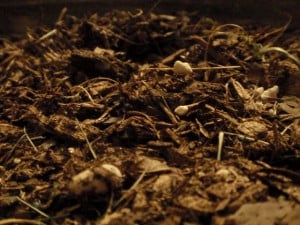Potting Medium: A Quick Guide
One of the key ingredients of a gorgeous, healthy container arrangement is potting medium. It is important to achieve the right balance within the potting medium for the specific plants being used in the arrangement. Potting medium can be made from a wide variety of materials to arrive at the perfect mix of drainage, nutrients, air circulation and more.
 Determining Your Needs
Determining Your Needs
First you need to know what your plants prefer in their mix. It is almost universal that plants need excellent drainage so that the potting medium doesn’t stay soggy and cause sensitive roots to rot. Some plants like to have very nutrient rich potting medium, full of organic material. Other plants like to have a very rocky and porous mixture. You also need to pay attention to the acidity of the potting medium. Many plants like a neutral potting medium, but some prefer it to be slightly acidic. The following are ingredients you can use to achieve the right balance for your container arrangements.
Ingredients
Several ingredients help create a potting medium that allows water to flow through while retaining some moisture for the roots to absorb.
Perlite, a common ingredient, is a “high-fired” volcanic rock. Perlite helps create a light, loose blend that allows water flow through easily.
Coarse sand or playground sand are cheap ingredients that help water move quickly through a potting medium.
Pine Bark accomplishes a two-fold job. It creates space in the potting mix to allow water and air circulation and adds nutrients as it decomposes.
Peat moss holds moisture allowing it to be released slowly for the plant to absorb. Peat moss also increases the acidity of the mix.
An alternative to peat moss is coir fiber. Coir is made from coconut fibers and behaves very similarly to peat moss. The only disadvantage of coir fiber is that it is slightly more expensive than peat moss.
Compost is an excellent nutrient rich base to start your mix with. Compost can be very dense so be sure to include ingredients that can lighten the mix.
Only use garden soil on rare occasions. When removed directly from the ground it can contain diseases and pests that will spread through your container plants. You can bake the soil to sterilize it, but it easier to start with a bagged mix. Note that you should avoid bagged mixes that include synthetic fertilizers if you plan to keep your container arrangements organic.
Other nutrient rich ingredients include composted chicken manure, worm castings, blood meal, bone meal, and kelp meal.
Limestone can be used to help balance the pH in soils that contain peat moss or pine bark. Add limestone to reduce the acidity of the mix.
Recipes
If you choose to mix your own potting medium, here are a couple recipes you can try:
Soil-less mix:
- 1/2 cu. yd. Sphagnum peat or coir
- 1/2 cu. yd perlite
- 10 lbs. bonemeal
- 5 lbs. ground limestone
- 5 lbs. bloodmeal
Soil based mix:
- 1/3 mature compost or leaf mold, screened
- 1/3 garden topsoil
- 1/3 sharp sand
Your Favorites
There are many different options for potting mediums. It may take some trial and error to find the perfect mix for your arrangements. Keep in mind that your soil should provide good drainage, appropriate pH, nutrients and air circulation. Your plants will thrive when you provide excellent potting medium.
What are your favorite potting medium recipes?
Sources
“Potting Soil ingredients.” Fine Gardening.
“10 Ingredients to make your own potting soil.” HobbyFarms.com
“6 Potting Soil Recipes.” HobbyFarms.com
“Potting Soil Recipes” Organic Gardening.
Image: Potting Soil by SidewaysSarah
You May Also Like
Leave a Reply
You must be logged in to post a comment.


















